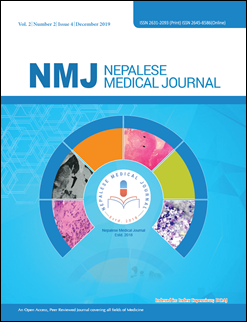Comparison of Use of Misoprostol versus Manual Vacuum Aspiration in the Treatment of Incomplete Abortion
DOI:
https://doi.org/10.3126/nmj.v2i2.25855Keywords:
Abortion; Incomplete; Vacuum aspiration; Misoprostol, MVAAbstract
Introduction: Early pregnancy failure is a major health problem throughout the world. Expulsion of some but not all products of conception before 20 weeks of pregnancy abortion is incomplete abortion. This study was to find about the safety, efficacy, and acceptability of misoprostol in comparison to manual vacuum aspiration for the treatment of incomplete abortion so the safe and convenient method can be used in diverse settings in different parts of our country.
Materials and Methods: A prospective comparative interventional study carried out between October 2011 to March 2012 AD (Kartik 2068 to Chaitra 2068 BS) in Paropakar Maternity and Women’s Hospital, Thapathali. All eligible women with a diagnosis of incomplete abortion of < 13 weeks of gestation either from LMP or Ultrasound were divided into two groups. Group 1 includes all odd numbers of cases under study group to whom 600 mcg Misoprostol was given orally. Group 2 includes all even the number of cases under study group to whom manual vacuum aspiration was done.
Results: Out of 60 women enrolled in the study, 30 were enrolled in Group 1(Misoprostol P.O.) and 30 in Group 2 (manual vacuum aspiration). The study showed no significant difference in the efficacy of the Misoprostol as compared to manual vacuum aspiration (93.33% vs. 100%).
Conclusions: The efficacy of oral Misoprostol is as effective as manual vacuum aspiration in the treatment of first trimester incomplete abortion with comparable success rate.
Downloads
Downloads
Published
How to Cite
Issue
Section
License
This license enables reusers to distribute, remix, adapt, and build upon the material in any medium or format, so long as attribution is given to the creator. The license allows for commercial use.
Copyright on any article published by Nepalese Medical Journal is retained by the author(s).
Authors grant Nepalese Medical Journal a license to publish the article and identify itself as the original publisher.
Authors also grant any third party the right to use the article freely as long as its integrity is maintained and its original authors, citation details and publisher are identified.




